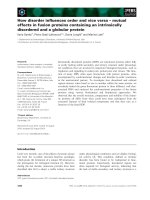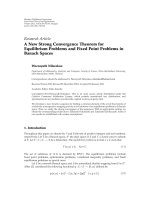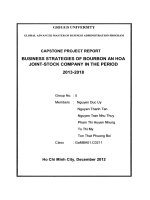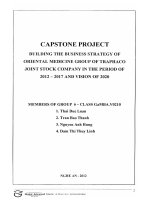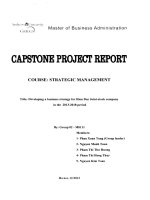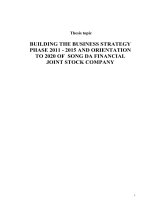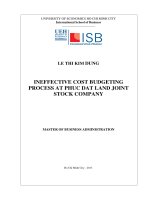An Applied Research and a Lean Manufacturing Process Construction for Garment Enterprises, Applied to Factory 123, Huu Nghi Garment Joint Stock Company
Bạn đang xem bản rút gọn của tài liệu. Xem và tải ngay bản đầy đủ của tài liệu tại đây (728.91 KB, 7 trang )
<span class='text_page_counter'>(1)</span><div class='page_container' data-page=1>
<b>Business, Management and Economics </b>
<b>Research </b>
<b>ISSN(e): </b>
<b>2412-1770</b>
<b>, </b>
<b>ISSN(p): </b>
<b>2413-855X</b>
<b>Vol. 3, No. 12, pp: 232-238, 2017 </b>
<b>URL: </b> />
<b>An Applied Research and a Lean Manufacturing Process </b>
<b>Construction for Garment Enterprises, Applied to Factory 123, </b>
<b>Huu Nghi Garment Joint Stock Company </b>
<b>Hong, Vo Thi Thu </b>
Doctor in Businness Administration, Dean of Business Administration Department, School ofTourism-Management-economics, Ba Ria-Vung Tau University, Viet Nam
<b>1. Introduction </b>
In the global economic era, many manufacturing companies have the need for improvements to achieve the
efficiency of their production systems. In addition to performance requirements, manufacturers need to address the
diverse needs of customers with accurate delivery terms, fast changing technology. For OEMs (Orginal Equipment
Manufactures), they need to standardize the production process according to quality standards.
Lean manufacturing is an appropriate tool for improving production systems that meet the requirements
mentioned. It is generally a systematic, continuous improvement process and focuses on adding value to the
customer by eliminating wastes in the production or service supply of an organization. This helps to cut costs,
optimize resource utilization, shorten production cycle times and service supply, and increase the ability to respond
flexibly to fluctuating requirements and increasingly demanding of customers.
Following is the process of manufacturing methods over time:
<b>Figure-1. The process of manufacturing methods over time</b>
The early 20th century was the era of craft production based on the ingenuity of workers (artisans). The solution
of this period was introduced by Frederich Taylor to standardization, time study, and standard operations. The craft's
<b>Abstract: </b>
The lean manufacturing system is stated the right tool to improve production systems in order tomeet the performance and change demands of today's rapidly evolved technology. The theory of the process is to
eliminate wastes, empower workers, reduce inventories, and ensure to meet customers’ requirements. The
purpose of this study is to construct a lean manufacturing process experimented at Factory 123, Huu Nghi
Company. This process is expected to be applicable to nationwide garment enterprises in Viet Nam.
The main issues are mentioned in this study:
- Assessment of the status (in Content 2)
- Arranging production facilities and warehouses for Factory 123 (in Content 3)
- Implementing 5s for Factory 123 (in Content 4)
- Purchasing policy (inventory) for Huu Nghi Company (in Content 5)
- Deploying a pilot scale group for Factory 123 (in Content 6)
- Lean the manufacturing process applied to Factory 123 (in Content 7)
- Training to help a thinking change in a positive way, aiming to apply this process in an active and continuing
(in Content 8).
<b>Keywords:</b>
Lean manufacturing process; Production; Industrial revolution 4.0.
1900’s 1930’s 1960’s Today
Craft
production
Mass
production
Lean
production
</div>
<span class='text_page_counter'>(2)</span><div class='page_container' data-page=2>
characteristics are single-piece production, based on the skill and ingenuity of the operator in terms of underserved
science and technology.
The mass production period (1930s) and Henry Ford suggested mass production in line to create continuous
flow of raw materials throughout the production process, standardizing the processes. The characteristics of mass
production are low-skill workers, they did a small job in the chain. This method is focused on output to save
production costs.
Techniques in production are now entering the modern era (industrial revolution 4.0), with core elements of
artificial intelligence, internet of things and big data (Figure 2). Industrial Revolution 4.0 focuses on research to
create leaps in agriculture, fisheries, medicine, food processing, environmental protection, renewable energy,
chemistry, new robots, 3D printers, self-driving cars, new materials (graphene, skyrmions, etc.) and
nano-technology.
<i><b>Figure-2. Industrial revolution 4.0 </b></i>
<i>. </i>
Today, Industrial Revolution 4.0 is taking place in developed countries such as USA, Europe and a part of Asia.
besides the new opportunities, the industrial revolution 4.0 also poses many challenges for humanity to face.
<b>2. Literature Review </b>
<b>2.1. Lean Manufacturing Process </b>
After the 1960s, global companies have been making efforts to improve the quality based on the successes and
effectiveness of Japanese companies. Innovative measures focused on eliminating all waste in the entire production
process - business is the foundation of a lean philosophy.
The lean process can be applied to many different industries and circumstances. Because its nature is focused on
eliminating wastes as well as effort to add value to customers, the range of applicable objects has crossed the line
of traditional manufacturing industries to expand into the areas of services such as healthcare, retail, tourism,
banking, offices, hospitals, etc.
<b>2.2. Lean Manufacturing Process in Viet Nam </b>
Because of the new demands of the 21st century for sustainable development and changable consumer trends,
Vietnamese enterprises are facing with many difficulties in capital, competitiveness and production force. These new
trends require businesses to ensure harmonious growth, improve productivity and quality, and be friendly with
environment.
In a survey conducted by the General Statistics Office in 2012 on the main causes of bankruptcy and dissolution
was nearly 70% of responses the cause of bankruptcy was ineffectiveness in production and business activities, 30%
was lack of capital for production, and 15% could not sell their products. These figures reflected the limitation in
management capacity, production capacity as well as the lack of stability, sustainability in production and business
of Vietnamese enterprises.
According to Nguyen Dang Minh, the main causes of bankruptcy of Vietnamese enterprises were due to the
small size and limited resources, so they faced many difficulties in production and business. However, thanks to their
Industrial Revolution 4.0
Developed on 3 main values:
Digital – biotechnology – physics
Artificial intelligence (AI)
Internet of things (IOT)
</div>
<span class='text_page_counter'>(3)</span><div class='page_container' data-page=3>
system without realizing that in order to apply successfully, it is necessary to have a serious investment and come
from the main needs of the business. Therefore, the number of manufacturing enterprises in Vietnam successfully
applied this method are very limited. Companies that applied successfully streanlined manufacturing system in
Vietnam: Ben Thanh Toyota, Dong Nam Viet Packaging, Nha Be Garment, Garment 10, and Viet Tien Garment
company.
It’s true that this system will open a new direction in the management thinking and management of operations of
Vietnamese enterprises. With the Vietnamese business environment, the system will provide useful tools to help
enterprises make the most effective use of available resources without requiring an increase in capital costs or other
intangible costs. By cutting existing wastes, production capacity will gradually increase over time, creating
sustainable development for each enterprise, thereby contributing to the sustainable development for each enterprises
as well as for the country.
<b>2.3. Lean Manufacturing Process </b>
The process for implementing this system is illustrated in Figure 3 below. This process begins by determining
the value to the customer, and ends with process improvement and motivation for improvement.
<i><b>Figure-3. Implementation process (theory) </b></i>
<i> </i>
The research was carried out to propose the lean manufacturing process that were effectively applied at Factory
123 and our expectation can be applied to garment enterprises in Vietnam. Based on a lean philosophy and process,
we will adapt the following system.
1
2
3
4
5
Determine
the value to
the customer
Draw a
line
chart
value
Identify
and
eliminate
waste
Create
flow and
pull the
customer
Towards
the goal of
perfection
and
innovation
Demands
of the
customer
- Flow chart
of value
- Measure the
current
performance
- Determine
the waste
- Practice 5s
- Visual
management
-
Self-managed
maintenance
- Fast
conversion
- Harmonize
the work
- Balance
production
</div>
<span class='text_page_counter'>(4)</span><div class='page_container' data-page=4>
Begin
<b>Tools </b>
Study materials
Collect and analyze statistical data,
and draw a chart of VSM value
Optimal model, teamwork, line balancing.
EOQ model inventory management policy,
partial synthesis.
.
Cognitive training by visual tools
Kaizen, quality group
Management and quality control process
Training to promote self-improvement
transfer the research results
Experienced lessons and report research
results
Finish
Synthesis, analysis of reseach
situation
Survey on the current state the
production system
Methods of layout of
workshop at Factory123
Inventory management process
according to the lean strategy
Implementing 5s for Factory 123
Initial implementing of quality
group for Factory 123
Implementing lean
manufacturing process
Training, transfer the research
results
Evaluate the results and report
<i><b>Figure-4. The process of the research (theory) </b></i>
<i><b> </b></i>
<b>3. Methodology </b>
<b>3.1. The Aims of the Study </b>
<b>General objectives: Applied research and lean manufacturing process construction help enterprises increase their </b>
competitiveness through:
Better control of production field with resources balanced (machines, people)
Reduce costs and meet customer requirements better.
</div>
<span class='text_page_counter'>(5)</span><div class='page_container' data-page=5>
<b>Tools </b>
Step 1
Step 2
Step 3
Step 4
Step 5
Step 6
Leadership thinking
Train emplyees, observes, attends
conference on strainlined
Tools 5s, Kaizen, work design,
space design
Current value chart (VSM)
Purchasing management, redesign
layout, quality team management
Evaluate effectiveness based on
customer benefit criteria
Draw future value line chart
Maintain implement continuing 5s,
quality group
Training to improve awareness
Develop the process of implementing the lean manufacturing process system for garment enterprises in
Vietnam, applying to production enterprises so far.
Write a report on the implementation of research results.
<b>3.2. Subjects and Delimitations of the Research </b>
Huu Nghi Garment Joint Stock Company (abbreviated as HUGAMEX) was renamed from Huu Nghi Garment
Company on March 31, 2002 with its predecessor, a small garment factory specialized in producing Jean-owned
jeans named 12 UNITEX.
<b>3.3. Scale of Activities </b>
Total area of the company is 39 020 m2, in which the workshop area is 22,370 m2 with more than 2800 new and
modern machinery and equipment, and constantly improve meeting the requirements of production technology,
exports of high garments are increasing of the market. The whole workshop was built into a solid house, industrial
design.
The company has 3000 employees with professional qualifications,high skills, trained regularly, work with high
productivity.
Production capacity: 1,000,000 Jacket per year, 2.000.000 products / pants / year.
The company is applying the technology of Ultrasonic sealing hitech without sewing thread.
Factory 123 is one of four affiliated factories, processing one fifth of the company's output but accounting for
about one quarter of the order value. The products are processed in factory 123 are often difficult products with the
small size and change the sample continuously.
<b>Procedure </b>
</div>
<span class='text_page_counter'>(6)</span><div class='page_container' data-page=6>
<b>4. Results </b>
<b>Quantity: The content of the research completed is 9, meeting the content requirements registered in the </b>
<b>contract. </b>
<b>Content 1: Research situation: Summarized the research and development of the lean production process in </b>
Vietnamese garment enterprises and in the world; Meet the requirements registered in the appendix of the contract.
<b>Content 2: Status analysis: The study proposes a process and conducts current status data collection. Data on </b>
the layout of equipment for production at processing factory, warehouse layout, inventory policy, late order rate and
percentage of defective products at Factory 123 were collected.
<b>Content 3: Lean layout design process: It helps facilitates smooth and reduces non-value added time to 4.42% </b>
(estimated), more than the 3% milestone registered in the contract appendix. The warehouse design process has
helped to make the material flowing through and reduces the non-value added to 4% (estimated), more than 3%
signed in the contract appendix.
<b>Content 4: Inventory management policies in a lean thinking: Inventory management policy applied to lean </b>
manufacturing systems that meets continuous improvement support requirements and helps to reduce inventory costs
by 3.3% (estimated), greater than the 3% registered in the Appendix. contract. The model proposed by the study is
easy to implement. However, in order to operate efficiently, the study recommends creating a good relationship with
suppliers to capture timely supply in the market in order to orient and adjust orders in different phases.
<b>Content 5: Implement and maintain 5S: The research has been implemented and maintained 5S for Factory 123 </b>
meet the initial registered requirements. In addition, through the implementation of 5S research helps to change the
mind of the worker as well as collect a lot of process data.
<b>Content 6: Implement the quality group (pilot): The implementation of the pilot group for factory 123 achieved </b>
the following results.
- Implement and maintain a successful pilot group and reduce the average error rate to less than 20% of the
initial registered requirement.
- Organizing and implementing the quality group of the Executive Board and the Quality Group is considered to
be effective.
- The psychology of the staff at the pilot field is considered positive.
However, because the concept is relatively new to the workers and the management, therefore, there are still
many mistakes in the implementation process but they have been overcome.
<b>Content 7: Lean process: The lean implementation process proposed in this research has been applied </b>
successfully (achieved index in the contents) at Factory 123. It means that it meets the initial registered
requirements.
This study proposes to implement this lean process for the whole company and for other garment enterprises in
Viet Nam.
<b>Content 8: Implement and Training: Organized training courses on 5S, quality tools, thought and lean process for </b>
workers at Factory 123. Successfully organized a workshop on "Implement lean Process" for Factory 123.
<b>5. Discussions </b>
1. The lean process proposed in this study demonstrates practicality by applying first successfully at 123
Factory, Huu Nghi Garment Company. The expected Research Group is given the opportunity to develop this
process for all Huu Nghi Garment Company to increase the practicality and persuasion of the process.
2. When applying the lean process proposed in the research into the actual production, the trainer can add or
omit the steps of the process. However, that extrapolation may lead to redundancy or lack of some basic
requirements for deployment.
3. The lean process proposed in this study is tailor-made to fit Vietnamese enterprises, especially tailors, so it
may not be suitable for joint stock companies or 100% companies of foreign investment capital.
4. If the business has not qualified to implement all six steps of the current process, they may proceed step by
step, but prioritize the order of the steps; Step 1- training is always given priority in deployment.
<b>6. Conclusion </b>
</div>
<span class='text_page_counter'>(7)</span><div class='page_container' data-page=7>
Nguyen, N. Q. (2007). Design inventory system applied to Cu Chi automobile Factory, Ho Chi Minh City University
of technology.
Nguyen, Q. H. (2010). Building quality control system at Cu Chi Automobile Factory, Ho Chi Minh City university
of technology.
Nikou, H. (2014). Comparative study of assembly line balancing methods in an automotive industry. Iran.
<i>Shili, S. (2011). The strategic role of lean production in SOE’s development. International Joumal of Business and </i>
<i>Management, 6(2):160-168 </i>
Shriram, S. (2014). Assembly line Balancing A Case Study in Silencer Manufacturing. India.
Taiichi, O. (1998). Toyota Production System: Beyond Large-Scale Production, Productivity.
</div>
<!--links-->
